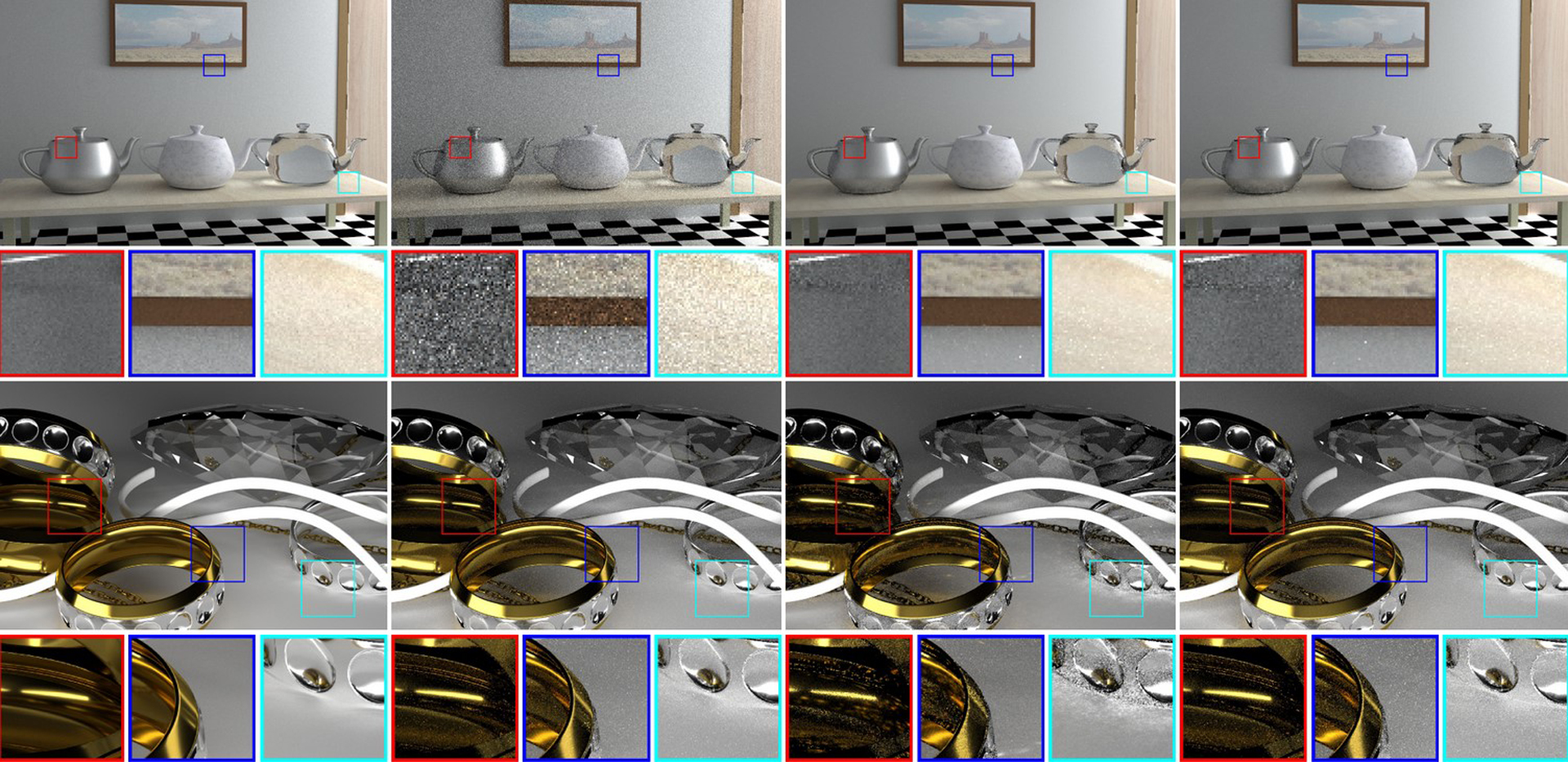“Fusing state spaces for markov chain Monte Carlo rendering” by Otsu, Kaplayan, Hanika, Dachsbacher and Hachisuka
Conference:
Type(s):
Title:
- Fusing state spaces for markov chain Monte Carlo rendering
Session/Category Title: Rendering in Path Space
Presenter(s)/Author(s):
Moderator(s):
Abstract:
Rendering algorithms using Markov chain Monte Carlo (MCMC) currently build upon two different state spaces. One of them is the path space, where the algorithms operate on the vertices of actual transport paths. The other state space is the primary sample space, where the algorithms operate on sequences of numbers used for generating transport paths. While the two state spaces are related by the sampling procedure of transport paths, all existing MCMC rendering algorithms are designed to work within only one of the state spaces. We propose a first framework which provides a comprehensive connection between the path space and the primary sample space. Using this framework, we can use mutation strategies designed for one space with mutation strategies in the respective other space. As a practical example, we take a combination of manifold exploration and multiplexed Metropolis light transport using our framework. Our results show that the simultaneous use of the two state spaces improves the robustness of MCMC rendering. By combining efficient local exploration in the path space with global jumps in primary sample space, our method achieves more uniform convergence as compared to using only one space.
References:
1. James Arvo. 1986. Backward ray tracing. In Developments in Ray Tracing, ACM SIGGRAPH Course Notes. 259–263.Google Scholar
2. Benedikt Bitterli, Wenzel Jakob, Jan Novák, and Wojciech Jarosz. 2017. Reversible Jump Metropolis Light Transport using Inverse Mappings. Technical Report. arXiv preprint arXiv:1704.06835v1.Google Scholar
3. Iliyan Georgiev, Jaroslav Krivánek, Tomáš Davidovič, and Philipp Slusallek. 2012. Light Transport Simulation with Vertex Connection and Merging. ACM Transactions on Graphics (Proc. SIGGRAPH Asia) 31, 6 (2012), 192:1–192:10.Google Scholar
4. Peter J. Green. 1995. Reversible jump Markov chain Monte Carlo computation and Bayesian model determination. Biometrika 82 (1995), 711–732. Google ScholarCross Ref
5. Toshiya Hachisuka, Anton S. Kaplanyan, and Carsten Dachsbacher. 2014. Multiplexed Metropolis Light Transport. ACM Transactions on Graphics (Proc. SIGGRAPH) 33, 4, Article 100 (2014).Google Scholar
6. Toshiya Hachisuka, Shinji Ogaki, and Henrik Wann Jensen. 2008. Progressive photon mapping. ACM Transactions on Graphics (Proc. SIGGRAPH Asia) 27, 5 (2008), 130.Google ScholarDigital Library
7. Toshiya Hachisuka, Jacopo Pantaleoni, and Henrik Wann Jensen. 2012. A Path Space Extension for Robust Light Transport Simulation. ACM Transactions on Graphics (Proc. SIGGRAPH Asia) 31, 6 (2012), 191:1–191:10.Google Scholar
8. Johannes Hanika, Anton S. Kaplanyan, and Carsten Dachsbacher. 2015. Improved Half Vector Space Light Transport. Computer Graphics Forum (Proc. Eurographics Symposium on Rendering) 34, 4 (2015), 65–74.Google Scholar
9. W Keith Hastings. 1970. Monte Carlo sampling methods using Markov chains and their applications. Biometrika 57, 1 (1970), 97–109. Google ScholarCross Ref
10. Wenzel Jakob and Stephen Marschner. 2012. Manifold exploration: a Markov chain Monte Carlo technique for rendering scenes with difficult specular transport. ACM Transactions on Graphics (Proc. SIGGRAPH) 31, 4, Article 58 (2012).Google Scholar
11. Henrik Wann Jensen. 1996. Global illumination using photon maps. In Proc. Eurographics Workshop on Rendering. 21–30. Google ScholarCross Ref
12. James T. Kajiya. 1986. The rendering equation. Computer Graphics (Proceedings of SIGGRAPH ’86) 20, 4 (1986), 143–150.Google ScholarDigital Library
13. Anton Kaplanyan, Johannes Hanika, and Carsten Dachsbacher. 2014. The Natural-Constraint Representation of the Path Space for Efficient Light Transport Simulation. ACM Transactions on Graphics (Proc. SIGGRAPH) 33, 4 (2014), 1–13.Google ScholarDigital Library
14. Csaba Kelemen, László Szirmay-Kalos, György Antal, and Ferenc Csonka. 2002. A simple and robust mutation strategy for the Metropolis light transport algorithm. Computer Graphics Forum 21, 3 (2002), 531–540. Google ScholarCross Ref
15. Joel Kronander, Thomas B. Schön, and Jonas Unger. 2015. Pseudo-marginal Metropolis Light Transport. In SIGGRAPH Asia 2015 Technical Briefs. 13:1–13:4. Google ScholarDigital Library
16. Eric P. Lafortune and Yves D. Willems. 1993. Bi-Directional Path Tracing. In Compugraphics ’93. 145–153.Google Scholar
17. Tzu-Mao Li, Jaakko Lehtinen, Ravi Ramamoorthi, Wenzel Jakob, and Frédo Durand. 2015. Anisotropic Gaussian Mutations for Metropolis Light Transport Through Hessian-Hamiltonian Dynamics. ACM Transactions on Graphics (Proc. SIGGRAPH Asia) 34, 6 (2015), 209:1–209:13.Google Scholar
18. Thomas Malley. 1988. A Shading Method for Computer Generated Images. Master’s thesis. University of Utah.Google Scholar
19. Enzo Marinari and Giorgio Parisi. 1992. Simulated tempering: a new Monte Carlo scheme. EPL (Europhysics Letters) 19, 6 (1992), 451.Google ScholarCross Ref
20. Jacopo Pantaleoni. 2017. Charted Metropolis Light Transport (SIGGRAPH ’17). ACM.Google Scholar
21. Peter Shirley, Bretton Wade, Philip M. Hubbard, David Zareski, Bruce Walter, and Donald P. Greenberg. 1995. Global Illumination via Density-Estimation. In Rendering Techniques 1995 (Proceedings of the Eurographics Workshop on Rendering). 219–230. Google ScholarCross Ref
22. Eric Veach. 1998. Robust Monte Carlo methods for light transport simulation. Ph.D. Dissertation. Stanford University, USA. Advisor(s) Guibas, Leonidas J. AAI9837162.Google Scholar
23. Eric Veach and Leonidas Guibas. 1994. Bidirectional Estimators for Light Transport. In Proc. Eurographics Workshop on Rendering. 147–162.Google Scholar
24. Eric Veach and Leonidas Guibas. 1997. Metropolis Light Transport. In SIGGRAPH ’97. 65–76. Google ScholarDigital Library
25. Bruce Walter, Stephen R. Marschner, Hongsong Li, and Kenneth E. Torrance. 2007. Microfacet Models for Refraction Through Rough Surfaces. Proc. Eurographics Symposium on Rendering (2007), 195–206.Google Scholar





